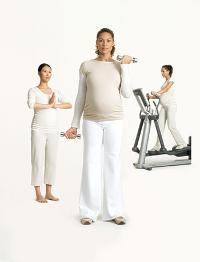
The Pregnant Woman’s Guide to the Gym
A an hour of cardio usually flies by for me at the gym, thanks to my secret motivational strategy: watching “Law & Order” reruns on the club’s TV. I hop on the elliptical machine as the opening credits roll, and before I know it, Sam Waterston is finishing his closing argument to the jury.
At least, that was the case before I got pregnant. In my first trimester, some days, to my amazement, I’d poop out 10 minutes into the show—before the detectives even identified the body.
“Many active women are surprised at how pregnancy affects their workouts,” says Renee M. Jeffreys, M.Sc., a prenatal-fitness consultant in Milford, Conn., and co-author of Fit to Deliver (Hartley & Marks). “But remember that these are normal, short-term changes.”
So should you dial down your cardio? Are certain machines off-limits? Can you still do Pilates? The answers depend largely on what your fitness level is, which trimester you’re in and how you’re feeling, Jeffreys says. But this much is certain: The gym is a great place to be pregnant. If one cardio machine or strength exercise isn’t comfortable, there’s always another one to try.
Getting yourself to the gym may take an extra dose of motivation, but the payoff is huge. Consistent exercise during pregnancy can minimize aches and constipation, help you sleep better, and lower your risk of gestational diabetes and depression. You may even end up having a shorter, less complicated labor. Developing good workout habits during pregnancy will help you get your body back faster after delivery too.
Though my first trimester was rough going, my second was a breeze, and my third wasn’t half bad, either. With my stamina back, I’d usually make it all the way through “Law & Order” at the gym—except, I’d spend the commercial breaks in the bathroom.
Whether you take classes, work out in the cardio room or lift weights, everything changes when you’re pregnant. Here’s how to adapt.
Class Action
If you have access to prenatal exercise classes, sign up. Not only are the workouts modified for pregnancy, but you also get to bond with your fellow moms-to-be over charming symptoms such as heartburn, swollen feet and hemorrhoids. You might even get labor tips.
If your favorite classes don’t come in the prenatal variety, it’s fine to keep going, as long as you pay attention to how your body feels, limit your intensity and stay within the normal range of motion. Just make sure the instructor knows you’re pregnant and is knowledgeable about modifications you can make, Jeffreys advises. If your instructor hasn’t worked with pregnant women, find one who has. Keep in mind that highly choreographed classes like Step aren’t the best choices for expectant women since they require quick direction changes and a heightened sense of balance. Hereare the most common classes you’ll find at the gym and what you need to know about benefitting from them whilepregnant.
Pilates Pilates helps maintain your abdominal muscle tone, which will support your growing belly, minimize back pain and give you more oomph for pushing during labor. But mat classes can be problematic after the first trimester because so much work is done lying on your back. Either opt out of these exercises or use an angled foam spine support (found in most Pilates studios but not many gyms); this will keep your head higher than your belly. You can still do the side-lying leg work, upper-body exercises and stretches.
Yoga Yoga not only strengthens your core and improves flexibility, but with its gentle movements and emphasis on breathing and meditation, it also fosters a sense of calm. In the second half of your pregnancy, avoid exaggerated twists and movements that tug on your belly, moves that require you to lie on your back or belly for prolonged periods, and inversions like headstands and shoulder stands.
Water aerobics Ah … relief. You can’t trip and fall; you won’t overheat; and for once you won’t feel like a big clod. No wonder water aerobics is a third-trimester favorite. Your joints will thank you! Wear aqua shoes so you don’t slip on the bottom of the pool.
Pregnant Woman , Pregnant Woman Health, Pregnant Woman Health Latest, Pregnant Woman Health Information, Pregnant Woman Health information, Pregnant Woman Health Photo,Exercising for Weight Health photo, Pregnant Woman Health Latest, Pregnant Woman Health latest, Exercising for Weight Health Story, Healthy Minnesota Health story, Pregnant Woman Video, Pregnant Woman video, Pregnant Woman Health History, Pregnant Woman Health history, Pregnant Woman over Picture, history, Pregnant Woman Asia, Healthy Minnesota asia, Pregnant Woman Gallery, Exercising for Weight gallery, Pregnant Woman Photo Gallery, Healthy Minnesota photo gallery, Pregnant Woman Picture, Pregnant Woman picture, Pregnant Woman Web, Malaysia Health, web Health, picture, video photo, video surgery, gallery, laparoscopy, virus, flu, drug, video, Health Health, calories, photo, nutrition, health video, symptoms, cancer, medical, beating, diet, organic, blister, exercise, weightloss, surgery, spiritual, eating, tips, skin, operation, bf1, The, Pregnant, Woman’s Guide, to, the, Gym





